Game Designer
Boss Combat Full Walkthrough
UE5
Boss Designs - The Cursed Waters of Xiangliu
Backstory of the Boss
Deep within the mist-veiled mountains, where ancient trees whisper forgotten legends and rivers carve through the land like silver veins, a traveler unknowingly wanders into a place long forsaken by time—the domain of Xiangliu.
Legends speak of Xiangliu, the monstrous nine-headed serpent that once served the wrathful water god, Gonggong. It devoured mountains, turned fertile lands into swamps, and poisoned the earth with its vile blood. Though the great Yu once struck it down, its presence lingers, festering in the depths of an accursed lake, waiting… watching… hungering.
Unaware of the looming danger, the traveler marvels at the beauty of the shimmering waters, only to sense an unnatural stillness—a silence too deep, a shadow too long. The villagers have long abandoned these lands, whispering fears of a demon that refuses to fade into myth.
But fate is unyielding. Whether by chance or destiny, the traveler now stands at the threshold of an ancient battle. The serpent stirs beneath the waves, eyes gleaming like molten gold, its many heads rising in a storm of rage.
The choice is clear. To flee and leave the land to its doom, or to stand and become the hero that time has forgotten.
Level Designs
This boss encounter is crafted to emphasize deception, exploration, and transformation. I used UE5 Landscape and Modelling Mode to finish sculpting the place.
-
Entrance & Luring Mechanic:
-
The level begins deep in the mountains, where players, driven by curiosity or necessity, unknowingly step into Xiangliu’s illusion.
-
The environment presents a beautiful lotus pond, an inviting and serene landscape that contrasts the eerie silence of the surrounding forest.
-
Visual and audio cues subtly hint at the unnatural nature of the place—such as lotus petals dissolving upon touch, faint whispers in the wind, and water reflections that distort unpredictably.
-
-
Boss Arena & Environmental Shift:
-
As the player ventures further, small inconsistencies build tension until the illusion shatters in a dramatic moment, revealing the horrifying reality:
-
The entry and boss area are designed with a stark contrast—the inviting pond vs. the dark, corrupted battleground, reinforcing the theme of deception.
- To accommodate ARPG gameplay, the boss area is kept spacious, ensuring room for dodging, attacking, and defensive maneuvers.
-
The figure-eight layout is designed for optimal combat flow, offering a balance between open sightlines and environmental cover.
-
The open space also enhances vertical and horizontal movement, ensuring dynamic positioning throughout the fight.
-
-

Boss Combat Designs
Combat Flow:
Phase1: Boss grows 2 tails around different sides of Arena. Boss's body is invincible for current phase.
Phase2: Boss is affected, unleashing a more powerful & intense attack.
Phase3: Boss is weak. Player can jump on its head to execute it.
Player Experience Flow:
Phase1: Help player learn Boss attacking patterns and the battleground.
Phase2: Help player master skills.
Phase3: Allow player to progress the mission. Reward Player with cool Boss execution.



My design philosophy: Cinematic & Player Satisfaction is important.
-
A great boss fight should provide both combat depth and a sense of achievement.
-
To enhance the demo experience and avoid repetitive combat, the third phase transitions into an execution finisher phase.
-
Once the boss is stunned, players can use height differences to jump onto the boss’s head for a finishing move, delivering a cinematic and satisfying climax.
-
Combat Skill Design
My design philosophy:
1. Combat Variety & Player Experience
-
Designed close, mid, and long-range attacks to create a diverse combat experience based on player positioning.
-
Each phase introduces new mechanics to maintain engagement and prevent repetitive gameplay.
2. Environment-Integrated Mechanics
-
To enhance immersion and avoid static combat ("pillar fighting"), the boss utilizes lotus leaves, lotus flowers, and other environmental elements as interactive mechanics.
-
These mechanics change based on the boss phase, encouraging movement and strategic adaptation.

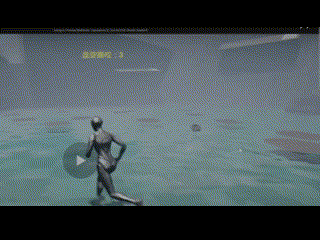
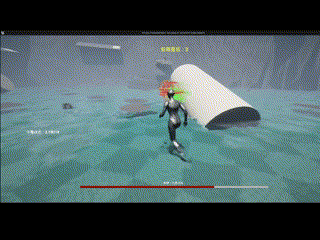
Fierce Bite
Venom Spread
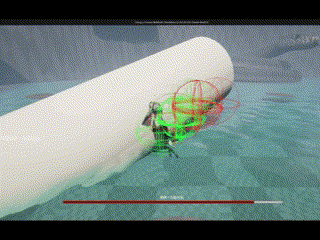
Tidal Impact
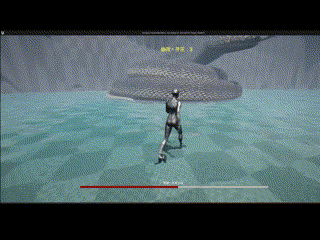
Nightfall Descent
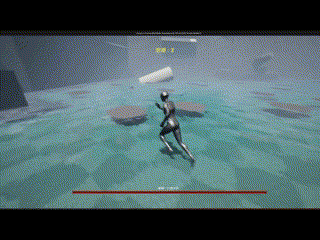
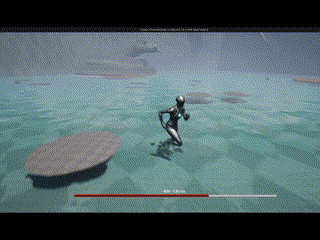
Raging Tides
Lotus Bloom
Implementation
Step 1: Build Boss UE Locomotives and import animations
I can't find appropriate art assets for each of the skills, so I only bond "Idle" and "Attack" state machines in Animation Blueprint.

Step 2: Organize architecture & Define Boss/player attributes
I decide to organize all the Boss skills under Snake Blueprint, and implement each of the skills with additional functions.

Snake status includes different phases check and UIs

Player status mainly includes: (De)buff effects.

Step 3: Implement each Boss & Player Skills
For Snake, I use yellow planes to represent VFX (damage area). For Player attacking range, I draw debugging spheres.
For player attack, I use UE5 Montage to tuning attacking timing and animation positions, playing attack animation sequence to perform a attacking coherent combo. I also process the animation and bonds them into the model.


For Snake, I implement each of the skills in BP. Importantly, I utilize timeline for UI Anticipation timer to make up for lack of anticipation animation assets, which will give player reaction time to think and improve combat clarity.

Step 4: Set Boss AI behavior tree
I implemented phase-based attack patterns using UE Behavior Trees, ensuring a structured yet adaptive AI.

The boss has a total 1200 HP, losing 1 HP per hit frame. A standard attack typically deals 15 HP damage, with combos inflicting even more. Following this rhythm, players will advance to the next phase after dealing 400 HP damage.
What I achieved in UE Behavior Tree?
Phase One:
-
The boss attack frequency is relatively slowly, with longer cooldowns between skills, and the skill intensity is lower.
Phase Two:
-
The boss’s attack frequency is more frequent, and the skills are more powerful compared to Phase One.
-
This phase incorporates parallel mechanics, allowing the boss to unleash multiple skills simultaneously.
Phase Three:
-
The snake stops attack pretty much.